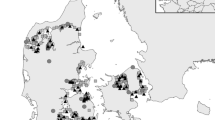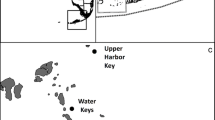Abstract
We present a comparative analysis of lower depth limits for growth of eelgrass, large brown algae and other macroalgae measured by SCUBA-diving along 162 transects in 27 Danish fjords and coastal waters, coupled to 1,400 data series of water chemistry (especially nitrogen) and Secchi depth transparency collected between March and October. Danish coastal waters are heavily eutrophied and characterized by high particle concentrations, turbid water and lack of macrophyte growth in deep water. Median values are 3.6 m for Secchi depth and median lower-depth limits are 4.0 m for eelgrass, 5.3 m for brown algae and 5.0 m for other macroalgae. Depth limits for growth of eelgrass and macroalgae increase linearly with transparency in the coastal waters. The relationships are highly significant (p<10−6) and transparency accounts for about 60% of the variability of depth limits. Eelgrass extends approximately to half the maximum depth of macroalgae, presumably because of greater respiratory costs to maintain the below-ground rhizomes and roots of eelgrass, which often constitutes half the plant weight. As a reflection of the importance of total nitrogen (TN) in controlling phytoplankton biomass and thus Secchi depth in coastal marine waters, we found that TN could explain 48–73% of the variation in depth limits of eelgrass and macroalgae, according to a multiplicative model (Y=aXb). As with Secchi depth, the relationship to eelgrass showed a lower slope, reflecting the higher respiratory costs of eelgrass. The models show great sensitivity and a profound quantitative response with proportional effects on Secchi depth and depth limits when total-N concentrations are reduced.
Similar content being viewed by others
Literature Cited
Anonymous. 1991a. Standarder for Vand og Miljø. Fysiske og kemiske metoder. Del 1. DS-Håndbog 21.1. DS-Håndbog, 1. Dansk Standardiseringsråd, Hellerup.
Anonymous. 1991b. Standarder for Vand og Miljø. Mikrobiologiske og biologiske metoder. Del 2. DS-Håndbog 21.2. DS-Håndbog, 2. dansk Standardiseringsråd, Hellerup.
Borum, J. 1983. The Quantitative Role of Macrophytes, Epiphytes, and Phytoplankton under Different Nutrient Conditions in Roskilde Fjord, Denmark. Proceedings of the International Symposium on Aquatic Macrophytes, Nijmegen.
Borum, J. 1996. Shallow waters and land/sea boundaries, p. 179–203.In B. B. Jørgensen and K. Richardson (eds.). Eutrophication in Coastal Marine Ecosystems. Coastal and estuarine studies. American Geophysical Union, Washington, D.C.
Boynton, W. R., J. D. Hagy, L. Murray, C. Stokes, andW. M. Kemp. 1996. A comparative analysis of eutrophication patterns in a temperate coastal lagoon.Estuaries 19:408–421.
Carlson, R. E. 1977. A trophic state index for lakes.Limnology and Oceanography 22:361–369.
Chambers, P. A. andJ. Kalff. 1985. Depth distribution and biomass of submersed aquatic macrophyte communities in relation to secchi depth.Canadian Journal of Fisheries and Aquatic Sciences 42:701–709.
Chambers, P. A. andE. E. Prepas. 1988. Underwater spectral attenuation and its effect on the maximum depth of angiosperm colonization.Canadian Journal of Fisheries and Aquatic Sciences 45:1010–1017.
Dillon, P. J. andF. H. Rigler. 1974. A test of a simple nutrient budget model predicting the phosphorus concentration in lake water.Journal of the Fisheries Research Board of Canada 31:1771–1778.
Duarte, C. M. 1991. Seagrass depth limits.Aquatic Botany 40:363–377.
Duarte, C. M. 1995. Submerged aquatic vegetation in relation to different nutrient regimes.Ophelia 41:87–112.
Duarte, C. M. andJ. Kalff. 1987. Latitudinal influences on the depths of maximum colonization and maximum biomass of submerged angiosperms in lakes.Canadian Journal of Fisheries and Aquatic Sciences 44:1759–1764.
Howarth, R. W. 1988. Nutrient limitation of net primary production in marine ecosystems.Annual Review of Ecology and Systematics 19:89–110.
Jeppesen, E., J. P. Jensen, P. Kristensen, M. Søndergaard, E. Mortensen, O. Sortkjær, andK. Olrik. 1990. Fish manipulation as a lake restoration tool in shallow, eutrophic, temperate lakes 2: Threshold levels, long-term stability and conclusions.Hydrobiologia 200/201:219–227.
Jones, C. G., J. H. Lawton, andM. Shachak. 1994. Organisms as ecosystem engineers.Oikos 69:373–386.
Kaas, H., F. Møhlenberg, A. Josefson, B. Rasmussen, D. Krause-Jensen, H. S. Jensen, L. M. Svendsen, J. Windolf, A. L. Middelboe, K. Sand-Jensen, andM. F. Pedersen. 1996. Marine Areas. Danish Inlets—State of the Environment, Trends and Causal Relations. Ministry of Environment and Energy, National Environmental Research Institute, Roskilde, Denmark.
Kikuchi, T. 1974. Japanese contributions on consumer ecology in eelgrass (Zostera marina L.) beds, with special reference to trophic relations and resources in inshore fisheries.Aquaculture 4:145–160.
Kirk, J. T. O. 1994. Light and Photosynthesis in Aquatic Ecosystems. Cambridge University Press, Cambridge, U.K.
Lathrop, R. G., R. M. Styles, S. P. Seitzinger, andJ. A. Bognar. 2001. Use of GIS mapping and modeling approaches to examine the spatial distribution of seagrasses in Barnegat Bay, New Jersey.Estuaries 24:904–916.
Laws, E. A. andJ. W. Archie. 1981. Appropiate use of regression analysis in marine biology.Marine Biology 65:13–16.
Littler, M. M. andD. S. Littler. 1985. Deepest known plant life discovered on an uncharted seamount.Science 227:57–59.
Markager, S. andK. Sand-Jensen. 1992. Light requirements and depth zonation of marine macroalgae.Marine Ecology Progress Series 88:83–92.
McCauley, E., J. A. Downing, andS. Watson. 1989. Sigmoid relationships between nutrients and chlorophyll among lakes.Canadian Journal of Fisheries and Aquatic Science 46:1171–1175.
Middelboe, A. L. andS. Markager. 1997. Depth limits and minimum light requirements of freshwater macrophytes.Freshwater Biology 37:553–568.
Nichols, S. A. 1992. Depth, substrate, and turbidity relationships of some Wisconsin lake plants.Transactions of the Wisconsin Academy of Sciences, Arts and Letters 80:97–118.
Nielsen, R., A. Kristiansen, L. Mathiesen, andH. Mathiesen. 1995. Distributional index of the benthic macroalgae of the Baltic Sea area.Acta Botanica Fennica 155:1–51.
Nielsen, S. L., K. Sand-Jensen, J. Borum, andO. Geertz-Hansen. 2002. Phytoplankton, nutrients and transparency in Danish coastal waters.Estuaries 25:930–937.
Nixon, S. W. 1997. Prehistoric nutrient inputs and productivity in Narragansett Bay.Estuaries 20:253–261.
Olesen, B. 1996. Regulation of light attenuation and eelgrassZostera marina depth distribution in a Danish embayment.Marine Ecology Progress Series 134:187–194.
Pedersen, M. F. andJ. Borum. 1996. Nutrient control of algal growth in estuarine waters. Nutrient limitation and the importance of nitrogen requirements and nitrogen storage among phytoplankton and species of macroalgae.Marine Ecology Progress series 142:261–272.
Pedersen, O. B., C. Christiansen, andM. B. Laursen. 1995. Wind-induced long term increase and short term fluctuations of shallow water suspended matter and nutrient concentrations, Ringkøbing Fjord, Denmark,Ophelia 41:273–287.
Prepas, E. E. andD. O. Trew. 1983. Evaluation of the phosphorus—Chlorophyll relationship for lakes off the precambrian shield in western Canada.Canadian Journal of Fisheries and Aquatic Science 40:27–35.
Read, J. F. 1974 Carbonate bank and wave built platform sedimentation, Edel Province, Shark Bay, Western Australia.American Association of Petroleum Geology Memoirs 22:1–60.
Ricker, W. E. 1973. Linear regressions in fishery research.Journal of the Fisheries Research Board of Canada 30:409–434.
Sand-Jensen, K. andJ. Borum. 1991. Interactions among phytoplankton, periphyton, and macrophytes in temperate freshwaters and estuaries.Aquatic Botany 41:137–175.
Schwarz, A.-M., I. Hawes, andC. Howard-Williams. 1996. The role of photosynthesis/light relationships in determining lower depth limits of Characeae in South Island, New Zealand lakes.Freshwater Biology 35:69–80.
Seip, K. L., H. Sas, andS. Vermij. 1992. Changes in Secchi disk depth with eutrophication.Archiv für Hydrobiologie 124:149–165.
Soral, R. R. andF. J. Rohlf. 1995. Biometry. W. H. Freeman and Company, New York.
Vant, W. N., R. J. Davies-Colley, J. S. Clayton, andB. T. Coffey. 1986. Macrophyte depth limits in North Island (New Zealand) lakes of differing clarity.Hydrobiologia 137:55–60.
Vollenweider, R. A. 1968. Scientific Fundamentals of the Eutrophication of Lakes and Flowing Waters, with Particular Reference to Nitrogen and Phosphorus as Factors in Eutrophication. DAS/CSI/68.27. OECD, Paris, France.
Ward, L. G., W. M. Kemp, andW. R. Boynton. 1984. The influence of waves and seagrass communities on suspended particulates in an estuarine embayment.Marine Geology 59:85–103.
Weisner, S. E. B. 1991. Within-lake patterns in depth penetration of emergent vegetation.Freshwater Biology 26:133–142.
Young, P. C. 1978. Moreton Bay, Queensland: A nursery area for juvenile penaeid prawns.Australian Journal of Marine and Freshwater Research 29:55–75.
Author information
Authors and Affiliations
Corresponding author
Rights and permissions
About this article
Cite this article
Nielsen, S.L., Sand-Jensen, K., Borum, J. et al. Depth colonization of eelgrass (Zostera marina) and macroalgae as determined by water transparency in Danish coastal waters. Estuaries 25, 1025–1032 (2002). https://doi.org/10.1007/BF02691349
Received:
Accepted:
Issue Date:
DOI: https://doi.org/10.1007/BF02691349




